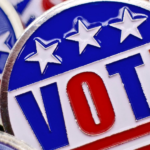US Top News and Analysis
Some of the biggest questions for market performance in 2023 may find answers in the first quarter of the year. Investors are wondering if the economy will sink into a recession, and whether the stock market will continue to sell off and set a new low. Then importantly, the big question: Will the Federal Reserve pause its rate hiking? Heading into the new year, there’s an unusually high level of consensus among Wall Street strategists in their stock market outlooks. The common view is that the stock market will perform poorly in the first quarter and probably the second, carving out a new low before improving into the end of the year. But according to market history, this coming quarter could be the best for the next four years. The first quarter of the third year of a presidential term is consistently the best quarter for S & P 500 performance, according to CFRA data. The index averages a 6.9% gain and is higher 90% of the time. For some perspective, the S & P 500 gained nearly 7.1%% in the fourth quarter, even though investors may feel it was down because of December’s lousy performance. That quarter, the final of the second year of a presidential term, is historically the second best and the average gain has been 6.5%, according to CFRA. CFRA chief investment strategist Sam Stovall also expects a volatile first half to be worse than the second half, but he calls the high level of agreement about this forecast on Wall Street “unnerving.” “It goes against the grain of history and it goes against the grain of cynicism, where it basically says, ‘Look, the strategists are going to be wrong,'” he said. “If everyone says the first half is going to be bad and the second half is going to be good, it could be the opposite. Maybe we’re going to pop before the drop.” Recession question The outlook for a volatile and down market in the first quarter also corresponds with many economists’ forecasts that the U.S. has entered or soon will enter a recession . The Fed’s rapid-fire series of interest rate hikes is seen as the culprit behind the anticipated downturn, so what the central bank does in the next couple of months will be key. “This is one where the Fed, without announcing it, is trying to create a recession,” said Ethan Harris, head of global economic research at Bank of America. The risk is the Fed will tighten too much, he added. “They can back off. That argues for a moderate recession unless something unforeseen happens,” he said. The Fed is trying to slow the economy to cool inflation which flared to the highest level in 40 years when the economy bounced back after the pandemic and supply chains became snarled. The central bank has raised interest rates seven times since March, and the fed funds rate target range is now 4.25% to 4.5%, a 15-year high. The Fed forecasts the benchmark rate will reach a peak of 5% to 5.25% in the first half of 2023, so there are potentially two or three more hikes coming. Consumer inflation has been slowing down, and was at an annual pace of 7.1% in November after rising to as high as a 9% rate in June. The December jobs report, due this Friday, and the consumer price index on Jan. 12 will be critical information ahead of the next Fed policy meeting on Jan. 31-Feb. 1. The Fed meets again on March 21-22, and before that meeting January jobs data will be released Feb. 3 and February employment is released March 10. CPI is reported on Feb. 14 and again on March 14. “I think what’s causing some people to believe the second half will be better is they expect the Fed to pause after the March tightening,” Stovall said. “If that doesn’t happen, we certainly could end up with the market taking a tumble.” The labor market has been surprisingly resilient, though the Fed is trying to cool it down. Economists expect another 217,500 payrolls were added in December and the unemployment rate is expected to remain at 3.7%, according to FactSet. Companies have been announcing layoffs, and that trend is expected to pick up in the first quarter. “One metric to watch is actually the unemployment rate,” said Jimmy Chang, chief investment officer of Rockefeller Global Family Office. He pointed to the economic rule that a recession has started when the unemployment rate rises by a half percent from its trough. Chang expects a recession to start in the first part of the year. Other data will also be crucial in the market’s deliberation over whether a recession is at hand. The housing market already looks to be in a recession, with pending home sales plunging, and retail sales will be important as a measure of the consumers’ health. The next retail sales report is Jan. 18. Wild cards As always, there is potential for geopolitical influences to change the forecast, like the war in Ukraine did in the past year. Analysts expect oil to trade higher than its current level, but they don’t foresee a big jump in prices like the past year. However, they do not rule out an energy spike if there are other developments. China is a major unknown for the price of oil, but also for the global economy. Its reopening could be a positive economic force, but it could also generate more inflation from increased demand for goods and commodities. There’s also the question of what the outcome will be from Beijing’s rapid removal of Zero-Covid restrictions while there is a record high number of cases. “That’s the wild card for 2023,” Chang said. “I think the next few months could be pretty volatile.” Chang expects the Chinese economy to improve in the next several months, particularly with the National Party Congress meeting in March. “The timing of the economic rebound probably starts in the second quarter so the market can look forward to it,” he said. “The next few months will be very difficult but hopefully by spring time, there will be sufficient herd immunity that will start to pick up,” he said. What earnings? Another event that could create volatility for stocks is the fourth-quarter earnings season. That starts in mid-January, with JPMorgan Chase’s earnings one of the first major reports on Jan. 13. “The earnings are expected to start a recessionary pattern in the fourth quarter,” Stovall said. “Right now it’s estimated to be down 3% year-on-year … We are looking at an earnings recession which is typically coincident with an economic recession.” Stovall said the first-quarter results, reported in April, are expected to be barely down, by 0.3% for S & P 500 companies. The second quarter is expected to be down 2.3%. “There’s never been a bear market that bottomed without a noticeable volatility spike, and that didn’t occur at all in 2022. That’s why the first half is likely to be a volatile one,” said Julian Emanuel, head of equity, derivative and quantitative strategy at Evercore ISI. “One thing you know with certainty is that earnings numbers are going to come down.” Emanuel says investors should stick to value stocks, or names that have been beaten up but have better earnings outlooks. He also recommends investors protect themselves from high volatility in both directions with S & P 500 options. After the worst year ever for bonds Bonds turned in their worst performance ever in 2022, shocking when the S & P 500 was also down 19.4% in its worst year since 2008. As central banks globally moved from zero and even negative interest rate policies, bond markets adjusted as yields rose. Yields move opposite price. Now bond market strategists see a rewarding time for bond investors in the coming year, as yields are higher and high-quality bonds can generate relatively safe income compared to volatile equities. “It does provide that recession-risk type of protection. At the same time, there’s just a lot of real value created without taking a lot of risk,” said Greg Peters, PGIM Financial co-chief investment officer. Peters expects to see more money flow into traditional bond funds “The funny thing about bonds is the worse it gets, the better it gets. The starting point is yields matter and carry matters. I think it changes the conversation. It changes allocations,” Peters said. “If I go back a year ago, a year-and-a-half ago, people asked why do I need bonds? Now it’s different. Getting that type of yield. Getting that type of carry income, bonds are doing what they’re supposed to do.” The carry is the difference between the yield on a bond and the cost of holding that instrument. Peters said there’s a chance the economy could escape a recession and instead see a soft landing in 2023. “Peeling it all back, investors have become so central bank driven, so liquidity driven when rates are at zero or negative,” he said. “When rates are higher, there’s more risks to the system. Central banks aren’t there to rescue at the drop of the dime, and quite frankly it’s a much more natural environment … You’ll see money in motion find its way into the bond market.”
Author Profile
Latest entries
 HeadlinesSeptember 20, 2024Cornell professor who praised Oct 7 Hamas attack joins another anti-Israel protest on campus
HeadlinesSeptember 20, 2024Cornell professor who praised Oct 7 Hamas attack joins another anti-Israel protest on campus ScienceSeptember 20, 2024What do young voters think about the 2024 election?
ScienceSeptember 20, 2024What do young voters think about the 2024 election? HeadlinesSeptember 20, 2024‘Bachelorette’ finalist Devin Strader addresses past arrest reports: ‘I know that I have made mistakes'
HeadlinesSeptember 20, 2024‘Bachelorette’ finalist Devin Strader addresses past arrest reports: ‘I know that I have made mistakes' ScienceSeptember 19, 2024Deadly snail venom could make diabetes medicines better
ScienceSeptember 19, 2024Deadly snail venom could make diabetes medicines better

